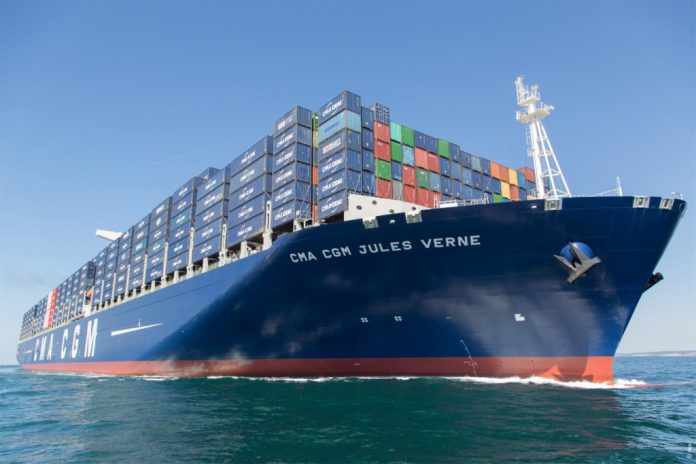Đồ Án Giao Nhận Vận Tải Biển 2019
Mọi ý kiến đóng góp xin gửi vào hòm thư: [email protected]
Kéo xuống để Tải ngay bản PDF đầy đủ: Sau “mục lục” và “bản xem trước”
(Nếu là bài nhiều công thức nên mọi người nên tải về để xem tránh mất công thức)
Bài liên quan: Tiểu Luận Ý nghĩa của xuất xứ hàng hoá đối với cơ quan quản lý Nhà nước về hoạt động Xuất nhập khẩu và Doanh nghiệp Xuất nhập khẩu 2019
Mục Lục
- INTRODUCTION
- CHAPTER 1: LAW AND METHODOLOGY BASE
- 1.1. Law resource .
- 1.1.1. Domestic laws.
- 1.1.2. International law.
- 1.2. Methodology.
- 1.2.1. Parties in Forwarding.
- 1.2.2. Documentary.
- 1.2.3. Other definition.
- CHAPTER 2: CARGO.
- 2.1. Specific of cargo.
- 2.1.1. Characteristics of cargo.
- 2.1.2. Packaging.
- 2.2. Transport route.
- 2.2.1. International transport.
- 2.2.2. Inland transport.
- CHAPTER 3: CONTRACT AND IMPLEMENT.
- 3.1. Contract.
- 3.1.1. Quotation.
- 3.1.2. Contract.
- 3.2. Implement.
- 3.2.1. Forwarding process.
- 3.2.2. Explanation.
- CONCLUSION
- Tải xuống tài liệu học tập PDF miễn phí
Tải ngay bản PDF tại đây:Đồ Án Giao Nhận Vận Tải Biển 2019
INTRODUCTION
Import and export activities are expanding and connecting business activities internationally, which is the most exciting area in the world economy. In line with the reform and development of the domestic economy in Vietnam, import and export activities have played an important role in all external economic activities and have become the main source of income for the country. The process of industrialization and modernization of the country. Recognizing the importance of the Party and State, we have affirmed: “Unceasingly expanding and assigning international cooperation in the fields of economy, science and technology, promoting import-export activities” These are the objective demands of the times. Entering into the process of industrialization and modernization, with specific development strategies in combination with effective implementation, up to now, certain achievements have been achieved in the economic development of the commune. The trade and export activities are considered as a particularly important task, playing a huge role in the development of the country and the Party. , the state reserved for priorities. Through that, utilizing and promoting their advantages, turning those strengths into a competitive international.
CHAPTER 1: LAW AND METHODOLOGY BASE
1.1. Law resource .
1.1.1. Domestic laws.
The Government of Vietnam has issued a number of legal documents regulating the responsibility for delivery and receipt of goods by agencies, organizations and enterprises in order to regulate the relationship arising from sales contracts, transportation, insurance, delivery, handling … as:
_ Circular No. 128/2013 / TT-BTC regulates customs procedures, customs inspection and control, export tax, import tax and tax administration for export and import goods.
_ Decision No. 2073 / QDVT on October 6, 1991 of the Ministry of Communications and Transport promulgating the regulations on loading and unloading, forwarding and preservation of cargoes at Vietnamese seaports.
_ Decree No. 114 / HDBT on May 27, 1991 of the Council of Ministers promulgating specific regulations on customs procedures and customs fees.
_ Vietnam Maritime Code carrying 40/2005 /QH11 dated 14 June 2005, Vietnam Maritime Regulations.
_ Commercial law 2005.
_ Custom law 2014.
_ Circular No. 15/2012/TT-BTC dated 08/02/2012 of the Ministry of Finance Promulgating the form of export and import goods declaration.
_ Circular No. 128/2013 / TT-BTC dated 10 September 2013 of the Ministry of Finance stipulating customs procedures; Customs inspection and supervision; export tax, import tax and tax administration for export and import goods.
1.1.2. International law.
Forwarding services under the “FIATA Code of Conduct for Forwarding Services” are “any service relating to the transportation, consolidation, storage, loading, packaging or distribution of goods and services. consultancy or related services, including customs matters, finance, insurance, payment, collection of documents relating to goods “.
_ The International Convention on carriage of goods by sea:
- The Hague Rule 1924 and the Protocols 1968 and 1979.
- Hamburg Rules 1978.
- Rotterdam Rules 2010.
_ The International Convention on carriage of goods by air: Warsaw 1929.
_ The International Convention on Multimodal Transport:
- UNCTAD ICC Rules for Multimodal Transport Documents.
- International Carriage of Goods by Road (CMR, 1956).
- Convention concerning International Carriage by Rail (COTIF, 1980).
- The Hague–Visby Rules.
- Hamburg Rules.
- Rotterdam Rules.
- United Nations Convention on International Multimodal Transport of Goods (MT, 1980).
1.2. Methodology.
1.2.1. Parties in Forwarding.
Goods receipt is a collection of operations and procedures related to the process of transportation to carry goods from the place of shipment (the shipper) to the place of receipt (the consignee).
Forwarding enterprises are enterprises dealing in various types of goods forwarding services in the society, including domestic freight forwarding enterprises and international freight forwarding enterprises. The product of the forwarding business is the freight forwarding service that the company acts as Forwarding Forwarder (Forwarding Agent).
According to Hamburg rules:
- Shipper: means any person by whom or in whose name or on whose behalf a contract of carriage of goods by sea has been concluded with a carrier, or any person by whom or in whose name or on whose behalf the goods are actually delivered to the carrier in relation to the contract of carriage by sea.
- Carrier means any person by whom or in whose name a contract of carriage of goods by sea has been concluded with a shipper.
- Actual carrier means any person to whom the performance of the carriage of the goods, or of part of the carriage, has been entrusted by the carrier, and includes any other person to whom such performance has been entrusted.
- Consignee means the person entitled to take delivery of the goods.
1.2.2. Documentary.
- Contract of carriage by sea.
Contract of carriage by sea means any contract whereby the carrier undertakes against payment of freight to carry goods by sea from one port to another; however, a contract which involves carriage by sea and also carriage by some other means is deemed to be a contract of carriage by sea for the purposes of this Convention only in so far as it relates to the carriage by sea.
- Bill of lading (B/L).
Bill of lading means a document which evidences a contract of carriage by sea and the taking over or loading of the goods by the carrier, and by which the carrier undertakes to deliver the goods against surrender of the document. A provision in the document that the goods are to be delivered to the order of a named person, or to order, or to bearer, constitutes such an undertaking.
- Master bill.
Master bill is a bill issued by the shipping line for the shipper, which only the owner of the vessel is authorized to issue.
When you pick up the Master Bill means that on the original bill has a logo of the shipping line. Although you book through the forwarder the original bill carrier is the shipping line.
After the original bill to consignee receipt of goods you have to send the original bill to the consignee, usually sent by air.
- House bill.
A bill of lading issued by a freight forwarder. Often covers a consignment of parcels from various shippers that has been grouped or consolidated by the forwarder. The forwarder may, for example, receive a single groupage bill of lading from the carrier, then issue a series of House B/Ls to the respective shipper.
House Bill still has the original bill and surrender bill. But this original bill was printed by the forwarder, on the original bill only has the logo of the forwarder’s company, not have the logo of the carrier (shipping line).
- Seaway bill.
In the international forwarding and transportation, there are some documents such as; sea waybill, liner waybill, ocean waybill, cargo receipts, data freight receipts. These are shipping documents that cannot be transferred. Sea waybill (or liner waybill) is a document issued by the carrier to a particular named consignee, whose consignee issues a valid certificate (such as a letter of credit). Sea waybill (or liner waybill) is a document issued by the carrier to a particular named consignee, whose consignee issues a valid certificate (such as identity card), so they can get the goods without having to present a seaway bill. This is the same as the bill of lading in that it also indicates the recipient’s name, but otherwise the recipient in the bill of lading must produce the bill of lading, and in the sea waybill is not necessary. Unlike the Bill of Lading, the shipping note has two main functions; is evidence of a contract of carriage by sea and is the carrier’s certificate of receipt of a certain quantity of goods as described on the consignment note, and commits to the person who presents the goods. Delivery of goods or valid documents in accordance with the name of the person indicated on the consignment note.
- Shipping note.
A detailed record of the goods sent by the shipper to the carrier requesting that the goods be stored on board the ship. These are the instructions needed to make the bill of lading and for the carrier to receive the goods. This is also the owner’s commitment to the carrier. In cases where the carrier makes a note of acceptance on the consignment note, there is a case of making a Booking Note as a legal basis for the carriage of goods.
- Delivery order.
When the goods arrive at the port of destination, the carrier or his agent issues to the consignee (or delivery agent) the delivery order (D/O) for him to receive the goods from the ship. In general, in order to receive a delivery order, the consignee must present original B/L, in case B/L is late, It is usually for the carrier if he fails to prove or does not present a valid legal document afterwards, and it is best to have a letter of guarantee (L/G).
- Mate’s receipt.
The receipt of the ship’s deputy after each shipment is received and placed on board. When the captain or the person on behalf of the carrier signs the bill of lading, the counter-note of the vice-captain shall be checked, if there is suspicion or bad comment on the package, the captain shall also note that reservation on the bill of lading. Therefore, in order to receive the perfect bill of lading, it is required that the receipt of the ship’s deputy be recorded.
- Cargo outturn report (COR).
A written record between the consignee or the representative of the consignee (forwarder) that reflects the condition of the goods that are not in perfect condition; torn, broken, perforated, distorted,… This record is only valid if signed by the carrier or on behalf of the carrier and it is made upon discovery of damaged goods but not yet unloaded from the ship. This record serves as the basis for the consignee to make a complaint to the carrier, if the carrier proves that he is not at fault, the carrier is exempt from liability and vice versa, he must be liable for those losses and damages. COR is commonly used with department stores.
- Receipt of receive on cargo (ROROC).
ROROC, after the completion of the loading, was signed between the shipper and the ship to determine the amount of cargo unloaded. On ROROC there is a full description of the excess, missing, damaged … and the records of the proof and the damage and damage.
- Cargo plan.
A detailed map of the location, the number of goods loaded on the ship. The map of the ship’s line drawn up on the basis of the shipment registration paper and the technical characteristics of each specific ship, the loading map of which is effective.
_With the shipper, receive the goods. It is the basis for the sender and receiver to know the expected time of loading and unloading of a particular shipment, on the basis of which the shipper prepares the means to receive the shipment of goods. It is possible to anticipate possible loss situations.
_With port; to prepare the means and human resources necessary for loading and unloading a specific kind of cargo at appropriate time.
- Cargo manifest.
This is a statement of information on the goods loaded on board, one of the documents that the carrier must submit to the customs office when the vessel enters and before the vessel leaves. This profile adds extra charges to the Freight manifest for the tax office to inspect and collect taxes if the law requires collection of taxes on freight. MOC is based on the bill of lading issued to the shipper.
- Cargo list.
The consignment note shall be drawn up by the consignor on the basis of information on such goods; The number, size, condition and condition of the package, marking … of the consignment note are given in advance to the carrier for a reasonable period of time. Basing on the consignment note, the carrier shall draw up the loading plan.
1.2.3. Other definition.
- Full container load (FCL).
FCL is a shipping term, consignor and consignee responsible for packing and discharging the container. When the consignor has a sufficiently large volume of cargo to accommodate one container or multiple containers, one or more containers are hired to ship.
- Less container load (LCL).
LCL is the consignment shipped in a container that the collector (carrier or consignee) is responsible for loading and unloading goods into and out of the container. When shipping, if goods are not enough to fill a container, the goods can be shipped by the method of retail.
- Container yard (CY).
A container yard is an area in a seaport or dry docks to contain FCL containers unloaded from a cargo ship or placed in containers prior to shipment.
With CY / CY shipment, the Shipper will tow the container at the designated shipping yard (on Booking confirmation). Shipping Lines are responsible for this container shipment when it is down at the port of loading (POL), ready to be loaded onto the ship until it is unloaded at the designated container yard at the port of discharge (POD). The Consignee will carry out import procedures, pick up and tow the container from the yard to their warehouse.
- Container freight station (CFS).
Container freight station is a warehouse system where LCL shipments of different shippers (import / export companies) are consolidated /grouped before being exported or deconsolidated / degrouped after importation.
CHAPTER 2: CARGO.
2.1. Specific of cargo.
2.1.1. Characteristics of cargo.
_ Name of goods: White wine Dr Zen Zen Riesling.
_ Material: The wine is made from the finest Riesling grapes.
- Total alcohol strength: 12.67% Vol.
- Actual alcohol strength: 10.73% Vol.
- Total extract: 55.3 g/l
- Sugar free extract: 22.7 g/l
- Residual sugar: 32.6 g/l
- Total acid: 5.4 g/l
- Free sulphur dioxide anhydrous liquid: 43 mg/l
- Total sulphur dioxide anhydrous liquid: 141 mg/l
- Density: 1.0070
- Cadmium (Cd): 0.0013 ppm
- Aren (As): 0.0031 ppm
- Mercury (Hg): 0.0085 ppm
- Lead (Pb): 0.0128 ppm
- Cooper (Cu) 02747 ppm
- Zinc (Zn): 0.7583 ppm
_ Volume: 750 ml
_ Origin of goods: Germany.
_ Methods of preservation: The White wine must be stored at a temperature of 12-15°C. Because it is fragile, these bottles must be placed in a wooden container, each bottle is a separate compartment to prevent breakage. Goods must be transported by container 20’.
2.1.2. Packaging.
_ The method of package: Because the quantity of goods are small, not enough to close and a 20 ‘ container so the goods will be transferred to the consolidator for consolidation, saving costs. The owner choose the method of package is less than container load (LCL).
_ Way to package:
- Bottles of wine with bark (by bark or synthetic substance) should be stored either upside down to minimize air exchange between the outside and inside air to prevent oxidation fast. Separate wine boxes must be marked to indicate the location of the wine.
- Six bottles of wine will be packed into a wooden crate, inserted hygienic material to prevent broken bottles. The weight of a bottle of wine is 1kg, the weight of a wooden crate is 1kg. In the box of 6 bottles of wine so the total weight of 1 barrel is 7kg. The length of the barrel is 50cm. The height of the barrel is 40cm. The width of the barrel is 30cm.
|
|
|
- To use of non-insulated containers avoids the buildup of hot air in the open space above the wine pallet and the continuous cooling at night. Instead, the pallets inside the container must be covered with insulating panels or similar materials.
_ Label:
+ The label in the bottle:
- The name of good.
- The name of producer.
- Year of manufacture.
+ The label in the barrel:
- The name of good.
- The name of producer
- Quantity of bottle.
_ Measurement and weight of the shipment:
| Gross Weight | Net Weight | Measurement |
| 1,260.00 KGS | 1,080.00 KGS | 14.4 CBM |
_ Specification of the Container 20’:
| Dimensions | Container 20’ | |
| Inside length | 19’4” | 5.89 cm |
| Inside width | 7’8” | 2.33 m |
| Inside height | 7’10” | 2.38 m |
| Door width | 7’8” | 2.33 m |
| Door height | 7’6” | 2.28 m |
| Capacity | 1,172 ft3 | 33.18 m3 |
| Tare weight | 4.916 lb | 2,229 kg |
| Payload | 45,999 lb | 21,727 kg |
| Gross weight | 52,915 lb | 23,956 kg |
_ Arrange the barrel to container:
- Six bottles of white wine are placed in a barrel.
- 15 barrels are stacked on a pallet (pallet size 1.5m x 2.5m x 0.15m).
- Total is 6 pallets in the container.
- The remainder in the container will be consolidated by the consolidator and then placed.
2.2. Transport route.
_ White wine is imported in Less Container Load (LCL) with a container 20’; FOB, Hamburg port, Incoterm 2010.
_ Port of loading: Hamburg port (Germany).
_ Port of discharge: Quy Nhon port (Vietnam).
|
|||||
|
|||||
2.2.1. International transport.
_ The cargo will be transferred from CFS Hamburg warehouse to Hamburg port (2.46 km), transit time is 2-4 days.
_ Mode of transport is sea transport, from Hamburg port, Germany to Tan Vu port, Hai Phong, Vietnam.
_ After moving the container onto the vessel. Ships will run directly from Hamburg to Haiphong, not allow transshipment.
_ The distance is 17,413.70 km, the shipment time is a month.
2.2.2. Inland transport.
_ After the shipping line delivery goods to Tan Vu Port, the transit time from 1-2 days.
_ Inland transport is the road way from Tan Vu Port (Dinh Vu Industrial Zone, DT356, Dong Hai 2, Hai An, Hai Phong) to Sao Do CFS Warehouse (268 Chua Ve Street, Dong Hai 1, Hai An, Hai Phong).
_ Total distance is 5.4 km, the travel time is 12 or 47 minutes.
CHAPTER 3: CONTRACT AND IMPLEMENT.
3.1. Contract.
3.1.1. Quotation.
LCL:
| POL | POD | ROAD FREIGHT | T/T |
| HAMBURG, GERMANY | TAN VU, HAI PHONG, VIETNAM | USD 600 | 1 MONTH |
Vietnam local charge import:
| Fee | USD/1unit | Total (USD) |
| DO | 30 | |
| CFS charge | $5/CBM | $72 |
| THC | $4.4/CBM | $63.36 |
| CIC | $2/CBM | $28.8 |
| Handling fee | $30 | |
| Electricity fee | 50 |
Cost of renting truck: 200,000 VND.
3.1.2. Contract.
SOCIALIST REPUBLIC OF VIETNAM
INDEPENDENCE – FREEDOM – HAPPINESS
FORWARDING CONTRACT
No: 2469792
Date:01/11/2017
Party A
Client: SNA TRADING JOINT STOCK COMPANY
Address: 48/ 191 Le Loi, Ngo Quyen, Hai Phong,Vietnam
Tel: 84.225 3655475
Fax: 84.225 3655474
Tax code: 9125783624
Account No: VND: 0591-000-258-558
USD: 0591-370-258-560
Bank: Vietcombank – Hai Phong Branch
Represented by: Ms. Ngo Thanh Thuy
Position: General Director
Party B
Forwarder: SCM EXPORT& IMPORT AND TRADING CO., LTD
Address: 218 Ngo Quyen Street, Van My Ward, Ngo Quyen District, HP
Tel: (0225) 3652389
Fax: (0225) 3652389
Tax code: 0201628429
Account No: VND: 66158017196
USD: 66158017197
Represented by: Mr. Nguyen Hong Minh
Position: Director
(Forwarder and client further also as “Contractual parties”)
This contract includes the following clauses:
CLAUSE 1: SCOPE OF THE SERVICE
Client consigns Forwarder to do customs clearance procedure, contract with shipping lines, terminals, stores and the relevant parties, transport and deliver the goods to Client.
- Name of goods, quantity:
_White wine Dr Zen Zen Riesling (750ml).
_ Quantity: 180 barrels
- Place of receiving the goods:
Hamburg port, Germany.
- Place of handing over the Goods
_ Forwarder shall deliver the Goods to Client at: Sao Do Warehouse
_ Address: 268 Chua Ve Street, Dong Hai 1, Hai An, Hai Phong.
- Time of receiving and delivering the Goods:
_ Time of receiving Goods by Forwarder: 15/11/2017
_ Delivery time: No later than the date 20/12/2017 at the Destination.
CLAUSE 2: DUTIES OF EACH PARTY.
- Duties of party A.
_ Having obligation to fulfill payment all local charge to Party B duty and timely.
_ Being responsible for providing necessary documents, time & place to take in charge, place of discharge/ unloading as well as commodity, types, quantity, measurement, gross weight.
_ Having responsible for shipment legally and the accurary of documents.
_ Being in charge of arranging cargo insurance and advising insuarer in case of loss damage,… Or require B to arrange cargo insurance on behalf of A by sending written form before cargo are delivered from warehouse of exporter and A will pay all insurance fee.
- Duties of Party B.
_ Arranging transporting schedule & delivering shipment to agreed destination safely as committed.
_ Being responsible for informing transport procedure until the delivery of cargo at destination.
CLAUSE 3: VALUE AND PAYMENT TERMS.
- Contract value.
Detailed quotation will be delivered to A. This detailed quotation is considered the indisputable appendixes for the contract.
- Payment term.
_ Payment is fulfilled by account transfer to B with 100% value of invoice in that month during 15 days from the day that A receive financial invoice basing on the mentioned information.
_ Bank fee are incurred by deposit.
CLAUSE 4: FORCE MAJEURE.
In the event of unforeseeable and supposedly unavoidable conditions such as traffic congestion, harbor harassment, natural disasters, war, violence, labor strikes, fire or other causes are understood to be unforeseen; the contract parties are not bound to implement this contract. However, when the conditions for alleged force majeure have been terminated, the two parties shall be responsible for implementing this contract by cooperating closely to resolve the problems (if any), unless otherwise agreed other written agreement implement.
CLAUSE 5: COMMON CLAUSE.
The two parties undertake to fulfill all the terms of the contract. In case of any problems, the two parties will negotiate and make an appendix of the contract. In the event that the dispute cannot be resolved by negotiation, it will be forwarded to the Vietnam International Arbitration Centre (VIAC) next to the Vietnam Chamber of Commerce and Industry (VCCI) in Hanoi for final decision.
Contracts for the establishment of 4 copies, each party holds 2 copies with the same legal value.
The contract is valid from 20/11/2017 to 20/11/2018.
| ON BEHALF OF CLIENT | ON BEHALF OF FORWARDER |
3.2. Implement.
3.2.1. Forwarding process.
3.2.2. Explanation.
F Step 1: Sign the forwarding contract with importer.
The forwarder company will sign a service contract with the importing company to import white wine Riesling, originate from Germany. Goods will be transferred from Hamburg port, Germany to Tan Vu port, Hai Phong, Vietnam. The contents of the contract shall be agreed upon by the two parties and the responsibilities of each party shall be clearly stated.
F Step 2: Design the transportation route.
The cargo will be transferred from CFS Hamburg warehouse to Hamburg port, then directly to Tan Vu port, Hai Phong, Vietnam. From Tan Vu Port (Dinh Vu Industrial Zone, DT356, Dong Hai 2, Hai An, Hai Phong), after completing all procedures, goods will be transferred to CFS Sao Do, Hai Phong (268 Chua Ve Street, Dong Hai 1, Hai An, Hai Phong).
F Step 3+ 4+ 5: Contact the importer and find the suitable vessel; notify the exporter about the place of delivery and Book reservation.
Based on the information provided by the importer, forwarder quickly finds and contacts the shipping line to ship the goods. After discussing and agreeing, the two parties will proceed to sign the contract. The forwarder of the importer party shall also notify the forwarder of exporter about the time and place of delivery of the goods.
_ Thời gian giao hàng:
_ Port of loading: Hamburg port, Germany.
_ Tên tàu:
F Step 6 : Booking note.
Renting a market ship for transporting goods is called warehousing. The owner contacted the carrier’s shipping agent, shipping agent or master, and made a booking note for the ship’s cargo.
Warehousing is only available on market rents, which are regularly charter ships operating on a fixed shipping route and on a predetermined route schedule.
F Step 7+8: Delivering the assignment; transport and transfer container at CFS.
Prepare sufficient documents, the exporter will deliver the goods from the CFS Hamburg warehouse to the port of Hamburg and clear the customs clearance.
F Step 9+10+11: Send SI to the shipping line; receive draft Master Bill; receive Master Bill and pay fee for shipping line.
Book Container Process – do SI and get B/L, include:
- Get quotation from shipping line.
- Get the schedule.
- Send booking note.
- Receive booking confirmation.
- Send SI before closing time.
- Receive bill draft.
- Check, revise & confirm bill draft.
- Receive Master Bill and pay fee for B/L.
The information in SI include:
- Booking No.
- Vessel No.
- Bill type.
- Freight and charge.
- Notify party.
- Container/ Seal No.
- Description of goods.
- Port of loading.
- Port of discharge.
F Step 12: Send set of document to agent in importing.
Issuing draft of Quotation and House Bill and send them to customer. If customer confirming information on them is reasonable, Quotation will be sent to customer.
Document staff sent documents relating to shipment to forwarding agent in importing country.
F Step 13: Checking the delivered document.
After receiving documents that the shipping line sent, document staff vouchers will: Check the information on the Master Bill’s draft that shipping line sent and confirm the correct information and require shipping line to issue Master Bill.
F Step 14: Taking the delivery order at the shipping line.
The next step, before the expected day of arrival from one to two days, forwarder will receive the ship’s arrival notice. Arrival Notice will inform the recipient about the time the ship to the port location and accrued expenses. After that, the forwarder staff will make the necessary procedures in shipping line and shipping agents to change the delivery order. There are 2 ways to pay charges are paid directly at the shipping agent or transfer bank accounts. When fully completed, shipping agent will provide 2 shipping delivery order signed and sealed. A command is used when making customs declarations and pay for customs, a command refers to the port to take the container out. In particular, the command staff gets pay attention to the validity period of the D / O (Delivery Order), if they have expired, they must hold the D / O on the carrier applied for the extension to D / O.
F Step 15+16: Customs procedures and clearance.
In this step, the document staff will use ECUS5-VNACCS software for customs declaration. Then the customs side will return the results of the flow. For this white wine, the result return is red thread. For red thread goods, the customs office will check the documents as well as inspect the actual goods at the port. For documents, the documentary staff should prepare the following documents: C / O, sale of contract (copy), B / L, import license. After going to port for changing the command, the forwarder has to registration cargo inspection. The results are retuned after 3-4 days, the forwarder bring test results to the Customs Branch for customs clearance.
F Step 17: Exchange order at port and receiving the shipment.
Prepare the following documents:
- Letter of introduction/ authorization.
- ID card.
- Delivery order.
- B/L.
- Documents about goods.
The forwarding agent will go to the port processing department to present the required documents, payment for the service and receive the port of consignment. The next step, forwarder go to the port’s port security department, presented the order receipt of port, receive the paper in and out of port, and drive to port. Next, the forwarding department at the port facility. the consignee will presented the order receipt of port; To supervise the receipt of goods from ships onto means of transport; receive delivery note. Finally, submit a receipt of the warehouse forwarding, return the paper in and out of port and return the goods to the warehouse.
F Step 18: Delivering the goods to the warehouse.
After receiving the goods, forwarder hire a truck to pull container to Sao Do warehouse.
F Step 19: Liquidating customs declaration form; transferring documents to customers for payment and implementing the reservations of records.
After completing the customs clearance and delivery to the customer, the delivery officer checks and re-arranges the documents into a complete set, the employee will return the documents back to the import and export company. The transport company also saved 1 set. And Carry out accounting for customers, include:
- Local charge
- Handling fee
- Fee for clearance the import
- Road freight charges pull goods to the warehouse CFS
Then the FWD will send the list of debts to customers, the customer will check and verify again. Once agreed, the FWD accountant issues a red bill. The director then signs and seals this note. Forwarders carry all the documents together with the Debt Settlement Notice to the customer. The customer shall pay after receiving the red invoice within the time limit stipulated in the contract.
Finally, the company will liquidate the contract and record.
CONCLUSION
Transport forwarding activities are the levers of the economy. In countries with developed economies in the world in goods transport and delivery was very developed and become effective service business of the country, played a significant part in trade in goods traffic of the country. Delivery activities reduced the cost of exporting and importing, international labour distribution, increase cooperative relationships between countries, is to arm the relationship between export and import. In fact, the goods and services in foreign trade business is very important to perform the delivery, help for foreign trade contracts are done smoothly and quickly. Have to say, thanks to the companies that specialize in providing logistics services and transport goods in foreign trade has accelerated the speed of processing the job to export a shipment abroad or import a shipment from abroad into the country. So that enterprises have more opportunities in international trade, saving time and costs.
Thanks to the implementation of the export of a specific shipment in large exercises, I have better understanding of the work that a delivery is made when receiving a shipment export mandate.











